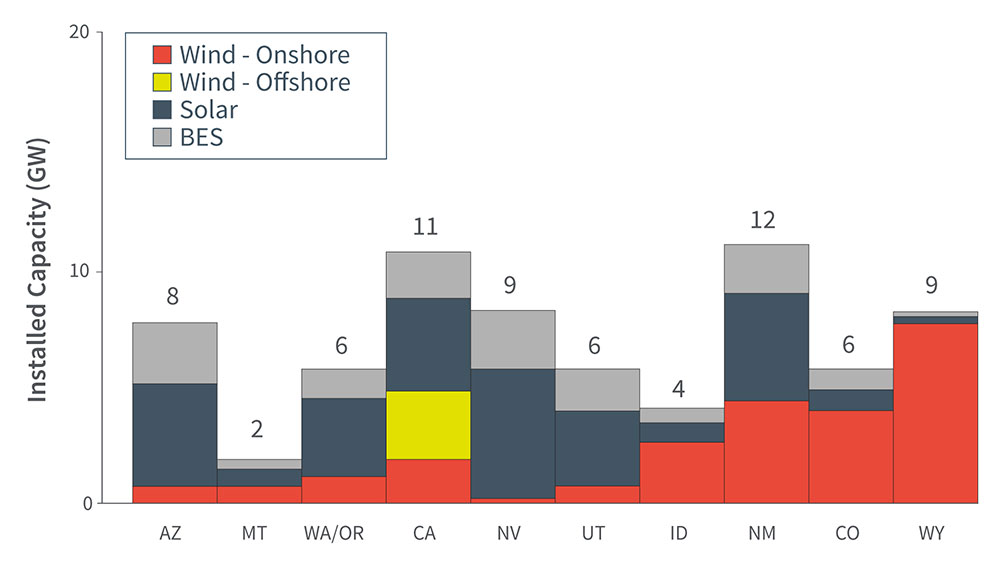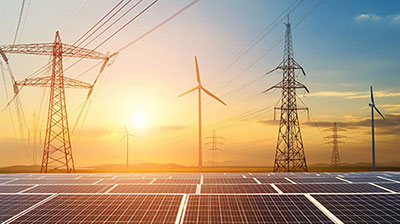The power of transmission: How grid modernization supports renewable integration and emissions reduction
By integrating various power system models, the Western Interconnection Baseline Study tests multiple transmission scenarios, using economic, reliability, and resilience indicators to guide decisions. The findings of the Study make it clear that significant investments in transmission infrastructure and renewable energy projects are essential to achieving decarbonization goals. By modernizing the transmission network and incorporating advanced renewable technologies and supportive infrastructure, the Western Interconnection can meet growing energy demands and reduce emissions, while enhancing system reliability.
The Western Interconnection
The Western Interconnection is a wide area synchronous grid that stretches from Western Canada down to Baja California in Mexico, and eastward over the Rockies to the Great Plains. This interconnected grid ensures that electricity can be efficiently transmitted across long distances, enhancing grid stability and reliability in more than a dozen U.S. states as well as British Columbia and Alberta in Canada.
As more intermittent renewable energy sources are integrated, maintaining grid stability and reliability becomes increasingly complex. Significant upgrades and expansions to existing transmission infrastructure are required to efficiently transport renewable energy from remote generation sites to urban load centers, overcoming regulatory and market barriers that can slow the integration process.
In response, the Study assesses how investments in transmission and renewable energy projects can help meet grid modernization needs and future decarbonization targets. By modeling a high renewable generation scenario for 2030, the study outlines a strategic approach that benefits consumers, guides regional planning efforts, and supports decarbonization while maintaining system reliability.
Two primary cases are modeled in the Western Interconnection Baseline Study: The Base Case, which reflects the industry’s existing 2030 plans, and the High Renewables (High RE) Case, which incorporates additional future renewable projects such as wind, solar, and energy storage. The Base Case utilizes the Western Electricity Coordinating Council’s 2030 Anchor Data Set (ADS), providing forecasts for generation, transmission, and load growth. The High RE Case adds 12 major future transmission projects and significant corresponding renewable energy development made possible by those additional transmission projects.
These scenarios are evaluated through production cost modeling and alternating current (AC) power flow modeling. Production cost modeling examines hourly operations across the Western Interconnection, offering insights into CO2 emissions, transmission congestion, renewable energy curtailment, and overall system costs. AC power flow analysis further assesses how well the system handles key interregional contingencies, allowing for detailed reliability studies. Interactive tools and databases help visualize and analyze system behavior across different scenarios.
We have thoroughly reviewed this report and on the High RE case specifically identified eight key study findings:
- Shift in generation mix: In the High RE scenario, 15% of fossil thermal generation energy is displaced with wind and solar, made possible by the expanded transmission network. This increased transmission capacity supports regions with significant renewable energy development and enables the distribution of clean energy to areas with new renewable capacity.

- Carbon reduction potential: The High RE scenario achieves a 73% reduction in CO2 emissions compared to 2005 levels, with the most substantial cuts in states like Utah, Nevada, Wyoming, Colorado, Arizona, and New Mexico, where renewables replace high emission fossil fuel power plants.
- Impact on fossil fuel plants: Fossil fuel plants, especially coal, experience a sharp decline (144 TWhr) in generation under the High RE scenario, with a 33% reduction for coal and 12% for natural gas. This reduced capacity will likely lead to early retirements of some of these plants due to higher operating costs and less frequent use. This impact is further compounded by the deployment of large energy storage systems. While not explicitly mentioned in the study, these fossil fuel plant displacements and utilization reductions should be aligned with their end-of-life projections and broader portfolio asset management planning to minimize stranded asset risks.
- Battery energy storage: Increased primary use case participation of battery storage systems to provide frequency response under the High RE scenario highlights this exponentially growing technology’s critical role in maintaining grid reliability in a renewable-heavy system.
- System resiliency: The High RE scenario demonstrates resilience in the face of high-impact contingencies, proving that the Western Interconnection can remain reliable and cost-effective with a significantly higher reliance on renewable energy.
- Shifts in regional energy transfers: Under the High RE scenario, California reduces its reliance on energy imports from the Northwest, shifting more to the Southwest. This shift takes advantage of new wind resources in Wyoming and New Mexico, easing transmission congestion and optimizing power flows across key transmission corridors.
- Renewable curtailment: Curtailments of wind and solar energy increase in the High RE scenario, especially during the spring months, when hydropower production is high, and demand is low. Options to minimize this curtailment would be to expand transmission capacity or add more energy for longer duration energy storage. Without such solutions, curtailments will likely worsen as more renewables are added to the grid.
- Cost savings: The High RE scenario lowers operational generation costs by 32%, although this analysis doesn’t factor in capital expenses for new generation and transmission infrastructure, which would be necessary for a full economic evaluation and was outside the scope of this study.
Conclusion
Upgrading the transmission network with advanced renewable technologies and supportive infrastructure allows the Western Interconnection to meet rising energy needs, lower emissions, and improve system reliability.
By acknowledging that the energy transition presents challenges, particularly around renewable curtailment and fossil fuel retirement, these obstacles can be addressed with strategic planning, technological innovation, and policy support. The sooner actions are taken, the greater chance that these challenges are minimized.
The future of a cleaner, more resilient energy grid is within reach, if we continue to invest in the core generation and transmission infrastructure that will enable it. Contact us to learn more about how our transmission and renewable integration experts are lighting the way.
Discover more on our expertise in transmission and integration
Unlock the potential of your projects with our unparalleled expertise in transmission and integration. Our team of seasoned professionals is dedicated to delivering innovative solutions that drive efficiency and reliability.
 Transmission and renewable energy integration are key drivers in reducing carbon emissions and lowering the cost of electricity generation. The Western Interconnection Baseline Study explores how new transmission and renewable energy projects can bring economic benefit and contribute to national carbon reduction goals.
Transmission and renewable energy integration are key drivers in reducing carbon emissions and lowering the cost of electricity generation. The Western Interconnection Baseline Study explores how new transmission and renewable energy projects can bring economic benefit and contribute to national carbon reduction goals.